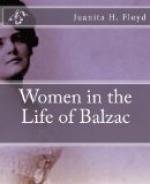“There are critics stupid enough to say that Balzac knew nothing of the art of painting young girls; they make use of the inelegant, unpolished word rate to qualify his portraits of this genre. To be sure, Balzac’s triumph is, we admit, in his portraits of mothers or passionate women who know life. Certain authors, without counting George Sand, have given us sketches of young girls far superior to Balzac’s, but that is no reason for scoffing in so impertinent a manner at the author of the Comedie humaine, when his unquestionable glory ought to silence similar pamphletistic criticisms. We advise those who reproach Balzac for not having understood the simplicity, modesty and graces so full of charm, or often the artifice of the young girl, to please reread in the Scenes de la Vie privee the portraits of Louise de Chaulieu, Renee de Maucombe, Modeste Mignon, Julie de Chatillonest, Honorine de Beauvan, Mademoiselle Guillaume, Emilie de Fontaine, Mademoiselle Evangelista, Adelaide du Rouvre, Ginervra di Piombo, etc., without mentioning, in other Scenes, Eugenie Grandet, Eve Sechard, Pierrette Lorrain, Ursule Mirouet, Mesdemoiselles Birotteau, Hulot d’Ervy, de Cinq-Cygne, La Fosseuse, Marguerite Claes, Juana de Mancini, Pauline Gaudin, and I hope they will keep silence, otherwise they will cause us to question their good sense of criticism.”
Balzac said it would require a Raphael to create so many virgins; accordingly, from time to time the type of woman of the other extreme is also seen. She is portrayed in the grande dame and in the courtisane, that is, at the top and the bottom of the social ladder. On the one side are the Princesse de Cadignan, the Comtesse de Seriby, etc., while on the other are Esther Gobseck, Valerie Marneffe, and others. Some of the novelist’s most striking antitheses were attained by placing these horrible creatures by the side of his noblest and purest creations.
In his Avant-propos, he criticized Walter Scott for having portrayed his women as Protestants, saying: “In Protestantism there is no possible future for the woman who has sinned; while, in the Catholic Church, the hope of forgiveness makes her sublime. Hence, for the Protestant writer there is but one woman, while the Catholic writer finds a new woman in each new situation.” Naturally, most of the women of the Comedie humaine are Catholic, but among the exceptions is Madame Jeanrenaud (L’Interdiction), who is a Protestant; Josepha Mirah and Esther Gobseck are of Jewish origin. In portraying various women as Catholics, convent life for the young girl is seen in Memoires de deux jeunes mariees, and for the woman weary of society, in La Duchesse de Langeais. Extreme piety is shown in Madame de Granville (Une double Famille), and Madame Graslin devoted herself to charity to atone for her crime.




